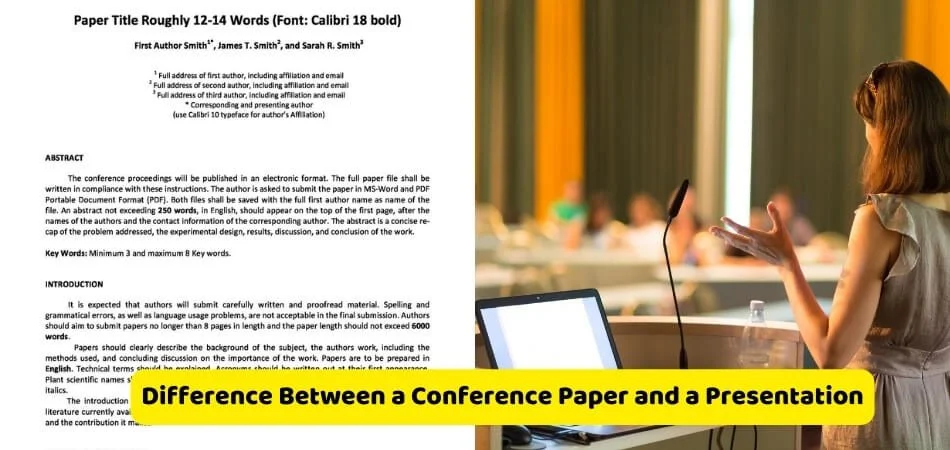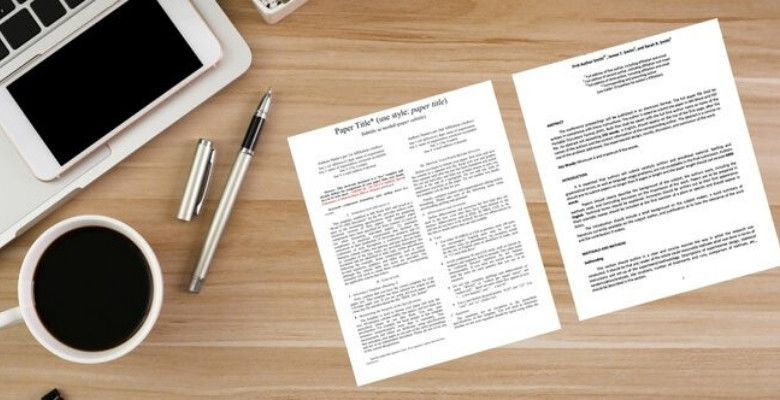Conferences bring people together to share new ideas, research, and knowledge in many different fields. When someone participates, they may wonder about the difference between written and spoken formats. This often leads to the question: what is the difference between a conference paper and a presentation?
The difference between a conference paper and a presentation is that a paper is a detailed written record, while a presentation is a brief spoken summary. The paper includes full research details for publication; the presentation highlights key points for a live audience in a short time.
Are you curious to learn how papers and presentations differ in format, purpose, length, and tools? If so, this article will guide you with all the necessary details. You will find clear explanations that make the topic easy to understand step by step.

What is the Difference Between a Conference Paper and a Presentation?
Conferences usually have two important parts: the paper and the presentation. Both play different roles but are connected to each other. A paper is detailed and published, while a presentation is short and spoken. Knowing the difference helps in understanding how research is shared clearly.
| Aspect | Conference Paper | Conference Presentation |
| Format | A written document | A live talk with slides, visuals, or a poster |
| Content | Full details of the research, including methods, data, and results | Summary of main points, highlights, and key findings |
| Purpose | To provide a complete record that others can read and build on | To explain the main ideas in a clear and engaging way |
| Length | Long and detailed, often several pages | Short, focused, usually within a time limit (10–20 minutes) |
| Review Process | Reviewed by experts before acceptance | Usually based on the accepted paper, not peer-reviewed separately |
| Publication | Published in conference proceedings (book, PDF, or online archive) | Not always published or archived |
| Audience Use | Read later for in-depth study | Heard and seen live during the conference |
| Delivery | Submitted before the conference, not read aloud | Delivered in person with visuals and speech |
| Focus | Completeness and detail | Clarity, engagement, and quick understanding |
| Example | Conference Paper | Conference Presentation |
Format
A conference paper is a written document with structured sections like introduction, methods, and results. A presentation is delivered live using slides, posters, or visuals. This difference becomes clear, especially for international events like arts and education conferences in Canada, the USA, or any other country, where papers are submitted first and presentations highlight them later.
Content
A paper provides full details of the research, including background, methodology, data, analysis, and references. A presentation highlights the most important findings only. Instead of covering everything, it simplifies the content to key points that can be quickly understood by a live audience within a limited time.
Purpose
The paper’s purpose is to serve as a permanent record of the research. It allows others to study or build upon the work later. The presentation’s purpose is to clearly explain the main ideas in a short time, helping the audience grasp the essence easily.
Length
Conference papers are usually long, often several pages, depending on the guidelines. They need to cover everything in detail. Presentations, however, are short and timed, usually 10 to 20 minutes. This makes them concise and focused only on the highlights, not the entire research.
Review Process
Papers are reviewed by experts before they are accepted for publication. This ensures quality and accuracy. Presentations usually depend on the paper’s acceptance and are not separately peer-reviewed. Instead, they are approved as part of the event schedule once the related paper is accepted.
Publication
Conference papers are published in official proceedings, either in printed books, digital PDFs, or online archives. This makes them accessible even after the event. Presentations, on the other hand, are usually not published. Unless recorded, they remain live experiences and are not stored for future reference.
Audience Use
Readers can refer to the paper later for a detailed understanding. It serves as a long-term source of knowledge. Presentations are mainly useful at the moment of delivery. They help the audience understand the main points quickly but are not usually available afterward for deep study.
Delivery
The paper is submitted before the conference and becomes part of the official record. It is not read aloud at the event. The presentation is delivered live by the researcher using slides or posters. It is about communication and interaction, not just reading the document.
Focus
A paper focuses on completeness and detail. It includes everything needed for replication or further study. A presentation focuses on clarity and engagement. It aims to hold the audience’s attention, explain ideas simply, and highlight the most important findings without overwhelming them with unnecessary detail.
While a paper serves as a full record, a presentation works as a summary of key insights. Both are connected but serve unique purposes. Readers can study the paper, while audiences listen to the presentation. Together, they make research more accessible and useful, especially during a conference paper presentation that highlights only the most important points.
What Format and Tools Are Used for Conference Papers and Conference Presentations?
Conference preparation depends on how your work will be shared—either in written form or through a live presentation. Both require a clear format and the right tools to be effective. Let’s look deeper into how they are usually prepared.
Paper Template
Conference papers usually follow a fixed template provided by the organizers. This template makes sure that every paper has the same structure, which helps readers. It often includes sections like abstract, introduction, methods, and results. Using the template also saves time because formatting is already set.
Citations Style
Papers must use proper citations to give credit to earlier work. Most conferences use common styles like APA, MLA, or IEEE, depending on the field. Authors have to carefully list their references at the end and match them with in-text citations. This keeps the paper professional and trustworthy.
Figures Captions
Figures, charts, or tables are very important in a paper. They make the content easier to understand and show data clearly. Every figure needs a caption that explains what it shows. Captions should be short but clear so readers can understand the point without reading everything.
Slide Design
Presentations are different from papers because they rely more on visuals. Slides should have large text that is easy to read even from a distance. Clean charts and simple images help the audience focus on the main points. Avoid putting too much text because that makes slides crowded.
Presentation Tools
The format often depends on the common types of presentations, such as oral talks, poster sessions, or virtual slideshows, each requiring slightly different tools. PowerPoint, Google Slides, and Keynote are the most popular options. These tools make it easy to create simple layouts with smooth transitions and clear visuals.
Conference papers and presentations have different styles but share the goal of sharing knowledge clearly. Following templates, using clean designs, and picking the right tools make both more effective for any audience.
How Do You Convert a Conference Paper Into a Clear Conference Presentation?
A paper has full details, while a presentation must show only the key points. To make this change, you need to trim, simplify, and design the content in a way that is easy to follow. Let’s go step by step.
Step One: Map Sections
Start by breaking down your paper into main sections such as introduction, methods, results, and conclusion. Map each section onto one slide. This gives structure and flow. Keep each slide focused on only the most important information instead of copying large text blocks from the paper.
Step Two: Trim Text
Long sentences from the paper should not appear on slides. Replace them with short points or keywords. This makes the content lighter and easier to scan quickly. Remember, slides support your talk; they are not the full paper itself. Keep the audience focused.
Step Three: One Idea
Do not mix too many points on one slide. Keep one clear idea per slide to avoid confusion. If you have several findings, spread them out across multiple slides. This makes the flow smoother and ensures the audience easily understands the main points you highlight.
Step Four: Label Charts
Charts are great for showing data, but they must be simple. Use large labels, bold headings, and clear titles. Avoid crowding the chart with small numbers or complex details. A chart should support your spoken words by showing only the main pattern or result clearly.
Step Five: Add Visuals
Use presentation tools like PowerPoint, Google Slides, or Keynote to make your slides more visual. Add images or icons only if they help explain the point. Keep the design neat, avoid clutter, and make sure visuals guide the audience rather than distract from your explanation.
Converting a paper into a presentation is all about cutting down, focusing on one idea per slide, and making visuals clear. By following these steps, you can turn detailed content into a presentation that is simple and powerful.
How Many Slides Should You Use for a Conference Presentation?
Slides play a central role in presenting ideas at a conference. The ideal number depends on session time, delivery pace, and personal style. Too many can overwhelm the audience, while too few leave gaps. Practical tips can help you strike the right balance. Let’s look at useful tips together.
- Plan Duration: Always check the total speaking time before creating slides. Knowing whether you have 10, 15, or 20 minutes will guide you to prepare the right number.
- Clean Layout: Each slide should be simple and not overloaded. A clean design with fewer words keeps the audience focused. Too much clutter will make the content difficult to understand and distracting.
- Time Balance: Spend about 45 to 90 seconds per slide. This keeps a steady pace, avoids rushing, and ensures every idea gets enough attention. Balanced timing makes the session smooth.
- Slide Count: For a 15-minute presentation, plan around 10 to 15 slides. This number allows enough time to explain clearly without skipping. Going beyond this usually feels rushed.
- Highlight Ideas: Use slides to show only the main ideas, not every detail from your notes. Let your voice add depth. This way, slides support your talk instead of replacing your spoken explanation.
- Practice Flow: Rehearse with the slides to check timing and flow. Practicing helps you notice if some slides need trimming. It also ensures you finish within the given time limit comfortably.
- Visual Support: Charts, images, and diagrams work well, but only if they are simple and clear. Overly detailed visuals slow down the pace. Use visuals to support one clear point per slide.
A strong presentation depends on balance. With the right number of slides, clear design, steady timing, and meaningful visuals, you can share your message effectively. Careful planning helps you keep the audience engaged from start to finish.
Do You Always Need a Paper to Give a Conference Presentation?
No, you do not always need a full paper to give a conference presentation. Some conferences only ask for an abstract, which is a short summary of your work. If the abstract is accepted, you can present your research without submitting a detailed paper. This makes it easier for many researchers to share their ideas.
However, some conferences require a full paper before allowing you to present. These papers go through a review process, and if accepted, they are published in the official conference proceedings. In these cases, your presentation is based on the paper, and both parts are linked together.
Because requirements are different for every event, it is important to check the official call for papers. That document explains clearly whether you need an abstract or a full paper. Reading the instructions carefully helps you avoid mistakes and ensures your submission meets the conference rules.
How to Structure an Abstract For a Conference Presentation?
Abstracts for conferences work best when they are short, clear, and direct. The goal is to provide just enough information to capture attention without overwhelming readers. Let’s look at the main parts you should include.
1. Context / Problem Statement (1–2 sentences)
Start by setting the stage. Explain the issue or gap your research addresses. This should hook the reader.
Example:
“Despite strong evidence that arts integration improves learning, 40% of U.S. schools cut arts programs between 2010 and 2020, creating deeper educational gaps.”
2. Purpose / Aim (1 sentence)
Clearly state the main goal of your study.
Example:
“This study examines how arts education affects student learning and suggests ways schools can adopt it widely.”
3. Methods (1–2 sentences)
Briefly explain how you did your research. Keep it short, but show the strength or novelty of your approach.
Example:
“We used a mixed-methods approach, reviewing 150 research articles, studying three successful school programs, and analyzing themes across them.”
4. Key Results (2–3 sentences)
Highlight the main findings with concrete data if possible. This section is the heart of the abstract.
Example:
“Schools with arts programs saw 18% higher math scores, 27% better vocabulary among ESL students, and 34% lower anxiety levels during online classes. The main challenges were limited funding (68%) and biased testing methods.”
5. Conclusions / Implications (1–2 sentences)
End with the “so what?” Why does this matter, and what should be done with your findings?
Example:
“Arts education boosts academic success and emotional well-being. To make this possible, schools must secure funding, train teachers in arts-based methods, and adopt inclusive policies.”
6. Originality / Contribution (Optional but useful)
Point out what’s new or unique in your work.
Example:
“This is the first study that connects arts education outcomes across learning, social, and policy levels.”
Key Tips for Writing
- Start with your most striking finding or fact.
- Be clear and avoid vague phrases like “significant impact.” Use numbers or concrete results.
- Stick to the word limit (reviewers reject over-length abstracts).
- Use keywords from the conference theme.
- Do not include citations.
- Make sure the title is strong and includes core terms (like “equity,” “STEAM,” or “learning outcomes”).
Common Mistakes to Avoid
- Adding too much background
- Forgetting to include results
- Using vague words without evidence
- Exceeding the word limit
- Leaving out why the findings matter
Writing a good abstract is about balance. You share the key points while keeping it short, clear, and interesting. When you follow this structure, your abstract has a better chance of catching the attention of conference reviewers.
What Common Mistakes Should You Avoid for Conference Papers and Conference Presentations?
Conference papers and presentations often include simple mistakes that reduce their impact. Such errors can confuse the audience and weaken your message. Avoiding them helps you share ideas more clearly. Let’s look at some of the most common mistakes below.
Reading Slides
One big mistake is reading long paragraphs directly from slides. Audiences do not enjoy listening to someone read word-for-word because it feels boring. Slides should support your talk with short points or visuals. Your speech should explain the ideas in detail while keeping the audience engaged and interested.
Tiny Text
Another mistake is cramming too much text onto one slide. Small text is hard to read, especially from a distance. Slides should use large, clear fonts and limited words. Fewer words force you to explain verbally, making the presentation smoother. Keep slides simple for best results.
Too Many Results
Presenters sometimes show too many results at once without a clear meaning. This confuses the audience and makes it difficult to understand the takeaway. It is better to highlight the most important results only. Explaining why those results matter is more valuable than filling slides with endless data.
Lack of Clarity
Cluttered designs, confusing charts, or overuse of jargon make content unclear. The purpose of a paper or presentation is to be understood easily. Use simple words, neat slides, and clear explanations. Avoid overloading with unnecessary details that do not add real value for your audience.
Paper vs Proceedings
One common mistake is not understanding conference paper vs conference proceedings, which often leads to confusion when submitting or citing work. A paper is your detailed research report, while proceedings are the published collection. Mixing them up can cause issues in credibility, citations, and official recognition of your work, especially when preparing or referencing a proceeding conference entry.
Avoiding these mistakes can make both your paper and presentation stronger. Always focus on clarity, not just content. Simple slides, focused results, and correct understanding help you shine. By being careful, your work leaves a lasting impression on the audience.
FAQs About What is the Difference Between a Conference Paper and a Presentation?
Before joining or preparing for a conference, people often get confused about the role of papers and presentations. Both have their own purpose and style, so it is useful to clear out common doubts. Here are some frequently asked questions with simple answers.
Can You Submit a Paper Without Giving a Presentation at a Conference?
Yes, it is possible in many conferences. Some conferences accept papers for publication in proceedings, but not all authors are invited to present. In such cases, your work is still part of the record but not shared on stage. Always check the event rules to see what applies.
Can You Give a Presentation Without Submitting a Full Paper?
Yes, some conferences only require an abstract for presentations. If the abstract is accepted, you can share your research live without sending a complete paper. This makes it easier for early-stage projects to be presented. It depends on the type of conference and the field.
Why Do Conferences Require Both Papers and Presentations?
Conferences often use both because each serves a different purpose. Papers give a permanent and detailed record that can be studied later. Presentations make it possible to explain key points quickly and interact with the audience. Together, they make research more accessible.
Do Papers and Presentations Have Different Audiences?
Yes, they often do. A paper is usually read by researchers and professionals who want to study the details later. A presentation is mostly for the live audience in the room, who want the highlights in a short time. Both formats reach people in different ways.
Can You Use the Same Content in Both Paper and Presentation?
Yes, but the way you share it changes. A paper allows you to include every detail, with data, analysis, and references. In a presentation, you only use the key findings and main points. The content is linked, but the delivery style is very different.
Do Conference Papers Count as Publications?
Yes, many conferences publish accepted papers in official proceedings. These can be in books, digital PDFs, or online libraries. Once published, your work can be cited by others, making it part of the academic record. This is why papers are often more formal than presentations.
How Do Presentations Add Value Beyond Papers?
Presentations allow you to connect directly with an audience. You can explain ideas in a simple way, use visuals, and answer questions in real time. This personal interaction helps people understand your work better. A paper alone cannot provide this type of engagement.
Can You Present the Same Paper at More Than One Conference?
It depends on the conference rules. Some allow it if the work is relevant to different audiences, while others require original and unpublished papers. Repeating the same paper without checking the rules can create problems. Always read the guidelines carefully before reusing work.
What Skills Are Needed for a Good Paper Vs a Good Presentation?
Strong writing skills, proper structure, and careful citation are essential for a paper. A presentation, on the other hand, requires clear speaking, good slide design, and the ability to explain ideas simply. Both demand preparation but test different communication skills. Practicing each makes your work stronger.
How Do Deadlines Differ for Papers and Presentations?
Paper deadlines are usually months before the conference, since they need time for review and publication. Presentation materials like slides are often due much closer to the event. Managing both timelines is important, so you do not miss key submission dates. Always plan ahead.
End Note
Conference papers and presentations serve different but connected roles in sharing knowledge. A paper is detailed, written, reviewed, and published as a permanent record, while a presentation is short, spoken, and designed for quick engagement. This gives the clear answer to what is the difference between a conference paper and a presentation.
Ending with a few tips, always keep papers well-structured, use clear references, and design slides that are simple and visual. Avoid clutter, focus on main points, and practice your delivery. With careful preparation, your work will leave a strong impression. Best wishes for your future conferences.








